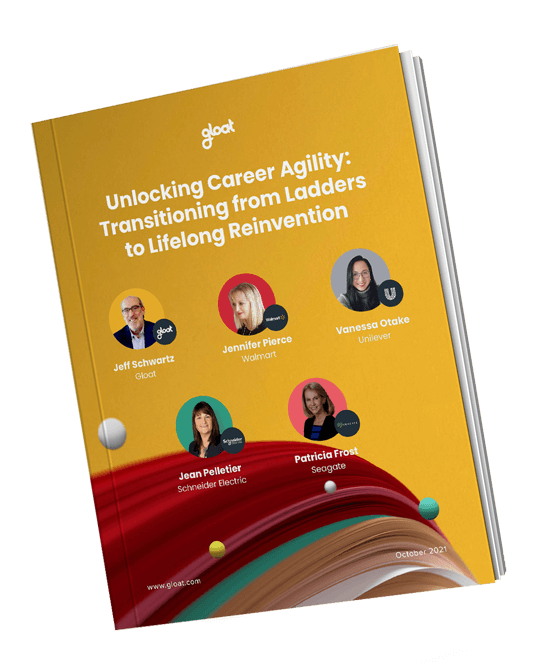Aligning employee career planning with business priorities
How to guide workers toward meaningful development with a talent marketplace

While layoffs continue to make headlines, that doesn’t mean that holding onto top talent is no longer a priority. In fact, as budgets tighten and skill gaps widen, companies need to ensure they’re retaining talent with in-demand expertise to sidestep the high costs associated with hiring and onboarding new employees. Consequently, it’s easy to understand why 93% of organizations are concerned about their current retention rates.
One of the most effective ways to encourage employees to stay with your organization is by demonstrating the various internal career growth opportunities you have to offer. Research shows that three of the top five factors that people consider when looking for a new job revolve around the position’s ability to develop their skills, pursue relevant learning and development, and provide opportunities for career growth.
As employees’ expectations shift and business priorities evolve, it’s up to HR leaders to rethink how career paths are structured to ensure they align with the needs of both their people and their business. Many executives are trading vertical, siloed development strategies for a more dynamic approach that puts skills in motion by empowering employees to take ownership of their professional progression.
What is career planning?
Career planning is about designing an actionable framework of relevant training, experiential learning opportunities, and progressions that align with business needs and employee ambitions. From a company’s perspective, showing employees the different career paths available to them can encourage them to develop within the enterprise while learning business-critical skills along the way. It’s also a proven employee retention booster, as recent LinkedIn research illustrates.
The four key elements of career planning include:
#1. Self-assessment
Employees need to reflect on their career ambitions and where they envision themselves within the next few years. Once they have an idea of where they’d like to be, they can discuss their goals with their managers and receive feedback based on their current performance. Career conversations are an excellent opportunity to align on the training and development opportunities that an employee should pursue to take their careers to the next level.
Launching a talent marketplace provides important context and background for professional development discussions. The platforms give employees and managers visibility into how their skills stack up for their current role, in addition to helping them identify capabilities to prioritize next.
#2. Career exploration
Employees should be encouraged to cast a wide net for career options that fit their skills and align with business priorities. Since many skills are transferable, an employee working in one business unit may already have most of the qualifications needed to move into a different role, even if it initially seems out of reach.
Talent marketplaces help break down the silos that often hinders employees from exploring roles in other functions or departments. The platforms surface relevant opportunities based on skills and aspirations alone, in turn, opening employees’ eyes to opportunities they may have once overlooked.
#3. Career identification
Once employees identify roles they’re interested in, they will need to learn more about each position to determine whether or not it’s truly a good fit for them. Informational interviews, mentoring, shadowing, and volunteering are a few examples of steps employees can take to deepen their expertise in prospective roles.
To give employees full visibility into the opportunities that align with their career goals, some companies are leveraging talent marketplaces. The platform’s AI surfaces roles and projects that are a good fit for employees based on their skills and ambitions and enables workers to learn more by connecting them with the related hiring manager.
#4. Action plan development
Employees need to set aside time with their managers to discuss career development opportunities. They can consider potential roadblocks and work together to create an action plan that outlines the steps they will need to take to move into this position.
To take professional development to the next level, leading companies are harnessing their talent marketplaces’ career planning capabilities, which allow employees to see various potential career paths. They can also drill down and surface recommendations for ways to bridge skill gaps, such as participating in projects and mentorships.
How does career planning benefit employees and businesses?
Prioritizing career development is a win-win. It boosts retention and morale while also ensuring businesses have the skills needed to outpace the competition. Some key benefits include:
Reduce attrition
Given that 67% of employees say that they would quit a job where internal mobility wasn’t offered, it’s evident that workers are placing a premium on career development opportunities. When companies invest in creating meaningful development pathways, it sends a signal to their workforce that they take their ambitions seriously.
Empower employees to achieve their full potential
While quiet quitting headlines have come and gone, leaders shouldn’t overlook the underlying sentiment that fueled the phenomenon: disengagement. When employees don’t care about the work they’re doing and they don’t feel challenged in their roles, they won’t perform to the same level as their peers who are excited about their career development prospects.
Meaningful growth opportunities are particularly important for engaging the newest members of the workforce. LinkedIn research reveals that Gen Z employees are over 50% more likely to value moving up the ranks, compared to Gen X.
Inspire professional development among employees
As workers begin honing their skills to move into new career opportunities, it will build positive momentum throughout the organization. Employees will take note of the training and development opportunities that their colleagues are participating in—and they’ll feel compelled to follow in their footsteps.
Prepare for unexpected challenges
Agility is the differentiator that determines which enterprises will thrive when faced with new challenges and which will struggle to survive. Employees who are building new skills as part of a career development plan will be better equipped to harness that expertise to pivot into new roles or projects as business needs change.
Improve efficiency and innovation
Building a skills-based organization is a top priority for most businesses, with 90% of companies noting that they’re actively experimenting with skills-based strategies. Career planning that prioritizes skill-building and encourages employees to participate in projects across the organization will pave the way for deploying skills to projects and tasks at enterprise scale. Businesses that embrace this skills-based approach are 49% more likely to improve processes to maximize efficiency and 52% more likely to innovate.
How to upgrade career development with a talent marketplace
Given the benefits associated with prioritizing career development, it’s easy to understand why many organizations are eager to create meaningful professional pathways for their employees. While career mobility options were once limited to moving up vertical ladders, modern career development is about developing portfolios of lateral and horizontal growth experiences that align with business needs and employee ambitions.
To connect employees to relevant skill-building opportunities across the organization, many companies are turning to talent marketplaces. These platforms generate recommendations for projects, gigs, and even full-time roles based on employees’ skills and ambitions.
Talent marketplaces also include career pathing functionality, which helps employees and candidates identify the world of professional possibilities within their organization. They can even see personalized career paths suited to their goals and interests, or chart a path to any role to uncover the skills they’ll need to turn their dream career into a reality.
To learn more about how to harness talent marketplaces to create meaningful professional development pathways, check out our guide on career agility.






